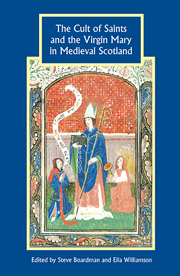Book contents
- Frontmatter
- Contents
- List of Illustrations and Tables
- List of Contributors
- Abbreviations
- Introduction
- 1 The Big Man, the Footsteps, and the Fissile Saint: paradigms and problems in studies of insular saints' cults
- 2 St Munnu in Ireland and Scotland: an exploration of his cult
- 3 The struggle for sanctity: St Waltheof of Melrose, Cistercian in-house cults and canonisation procedure at the turn of the thirteenth century
- 4 Royal and aristocratic attitudes to saints and the Virgin Mary in twelfth- and thirteenth-century Scotland
- 5 A saintly sinner? The ‘martyrdom’ of David, duke of Rothesay
- 6 Wo/men only? Marian devotion in medieval Perth
- 7 Is eagal liom lá na hagra: devotion to the Virgin in the later medieval Gàidhealtachd
- 8 Scottish saints' legends in the Aberdeen Breviary
- 9 Mothers and their sons: Mary and Jesus in Scotland, 1450–1560
- 10 The ‘McRoberts thesis’ and patterns of sanctity in late medieval Scotland
- Index
4 - Royal and aristocratic attitudes to saints and the Virgin Mary in twelfth- and thirteenth-century Scotland
Published online by Cambridge University Press: 05 October 2013
- Frontmatter
- Contents
- List of Illustrations and Tables
- List of Contributors
- Abbreviations
- Introduction
- 1 The Big Man, the Footsteps, and the Fissile Saint: paradigms and problems in studies of insular saints' cults
- 2 St Munnu in Ireland and Scotland: an exploration of his cult
- 3 The struggle for sanctity: St Waltheof of Melrose, Cistercian in-house cults and canonisation procedure at the turn of the thirteenth century
- 4 Royal and aristocratic attitudes to saints and the Virgin Mary in twelfth- and thirteenth-century Scotland
- 5 A saintly sinner? The ‘martyrdom’ of David, duke of Rothesay
- 6 Wo/men only? Marian devotion in medieval Perth
- 7 Is eagal liom lá na hagra: devotion to the Virgin in the later medieval Gàidhealtachd
- 8 Scottish saints' legends in the Aberdeen Breviary
- 9 Mothers and their sons: Mary and Jesus in Scotland, 1450–1560
- 10 The ‘McRoberts thesis’ and patterns of sanctity in late medieval Scotland
- Index
Summary
What follows is an attempt to contextualise the fragmentary and dispersed evidence on local and insular saints in the kingdom of the Scots in the central middle ages, and to understand better the ramifications of Europeanisation and other well known, sweeping changes on their cults. These changes, which included the restructuring of the church establishment under greater papal control, the massive growth of the Cistercians and other reformist monastic orders, and the expansion of power by the Norman and Angevin kings of England across Britain and Ireland, amounted to tectonic shifts in the religious life of a kingdom. How the familiae of saints like Columba, Cuthbert, Kentigern and lesser-known others maintained relationships with the kings, aristocracy and their newfound reformist brethren is the subject of this paper.
Saints' cults in the kingdom of the Scots
It is well known that familiae devoted to various saints were commonplace throughout northern Britain in the early and central middle ages. Charters, notitiae of donations and foundation accounts make clear that gifts to communities at places like Durham, St Andrews, Abernethy, Loch Leven and Deer were often seen as donations made directly to the saint himself (or herself), rather than to institutions. Such gifts comprised an important element in the network of relationships which made these saints and their familiae central to medieval Scottish society.
- Type
- Chapter
- Information
- Publisher: Boydell & BrewerPrint publication year: 2010

